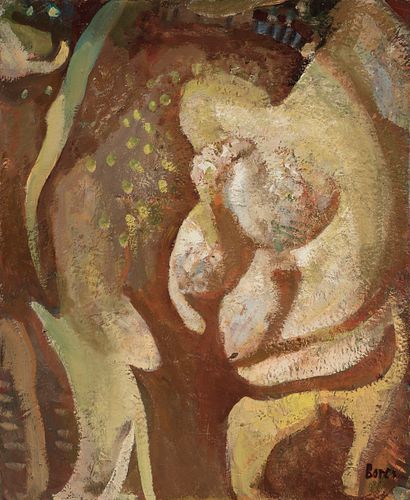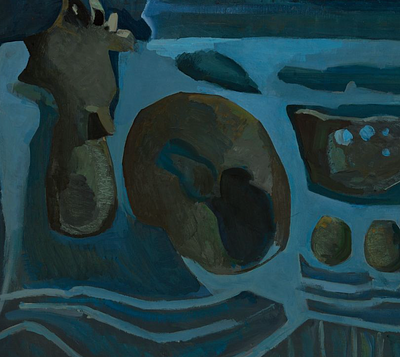FRANCISCO BORES LÓPEZ (Madrid, 1898 - Paris, 1972). "L' Arbre", 1966. Oil on canvas.
Lot 97
About Seller
Setdart Auction House
Carrer Aragó 346
Barcelona
Spain
Setdart Subastas was born in 2004 and is currently the first online art auction in Spain with solidity, prestige and reliability guaranteed by our more than 60,000 users. Setdart has a young, dynamic and enterprising team ready to successfully manage the purchase and sale of art works through custom...Read more
Estimate:
EUR€7,000 - EUR€9,000
$7,526.88 - $9,677.42
Absentee vs Live bid
Two ways to bid:
- Leave a max absentee bid and the platform will bid on your behalf up to your maximum bid during the live auction.
- Bid live during the auction and your bids will be submitted real-time to the auctioneer.
Bid Increments
| Price | Bid Increment |
|---|---|
| EUR€0 | EUR€10 |
| EUR€200 | EUR€25 |
| EUR€500 | EUR€50 |
| EUR€1,000 | EUR€100 |
| EUR€3,000 | EUR€200 |
| EUR€5,000 | EUR€500 |
| EUR€10,000 | EUR€1,000 |
| EUR€20,000 | EUR€2,000 |
| EUR€50,000 | EUR€5,000 |
About Auction
By Setdart Auction House
Jul 27, 2021
Set Reminder
2021-07-27 08:00:00
2021-07-27 08:00:00
America/New_York
Bidsquare
Bidsquare : CONTEMPORARY AND ACTUAL ART
https://www.bidsquare.com/auctions/setdart-auction-house/contemporary-and-actual-art-7261
Setdart Auction House sofia@setdart.com
Setdart Auction House sofia@setdart.com
- Lot Description
FRANCISCO BORES LÓPEZ (Madrid, 1898 - Paris, 1972). "L' Arbre", 1966. Oil on canvas. Signed in the lower right corner and titled on the back. Work reproduced in the catalog raisonné of the artist Volume II No. 511. Size: 60 x 51 cm; 83 x 72 cm (frame). Contemporary Spanish painter, belonging to the so-called New School of Paris, Francisco Bores was formed in the painting academy of Cecilio Pla, where he met Pancho Cossío, Manuel Ángeles Ortiz and Joaquín Peinado, among others. He also frequented the literary gatherings in Madrid related to ultraism. During this period he made engravings for a large number of magazines, such as "Horizonte" or "Revista de Occidente", and attended the Academia Libre de Julio Moisés, where he coincided with Dalí and Benjamín Palencia. In 1922 he participated for the first time in the National Exhibition of Fine Arts, and three years later he showed his work at the first Exhibition of the Society of Iberian Artists, but the lack of interest of the Madrid public for young art prompted him to go to Paris. In the French capital he came into contact with Picasso and Juan Gris, and made his individual debut in 1927, contracted by the Percier Gallery. During these years, and through his friendship with Picasso, he began his relationship with the art critic Tériade, who dedicated an extensive article to him in "Cahiers d'Art". It was at this moment that his artistic career began to take off. In 1929 he participated in the exhibition "Spanish painters and sculptors living in Paris", held at the Botanical Garden in Madrid. Also around this time he collaborated in avant-garde magazines such as "Litoral", "La Bête Noire", "Martín Fierro", etc. In 1931 he had a solo exhibition at the Georges Bernheim Gallery in Paris, and at the same time he signed a contract with the Swiss gallery owner Max Esiherberger. In 1932 and 1933 he exhibited at the Vavin-Raspail gallery in Paris, coinciding with the appearance of the first monograph on his painting. In the mid-1930s he was hired by the Zwemmer Gallery in London, where he held a solo exhibition. His work was influenced by Picasso's cubism and, at times, by surrealism and abstraction. After World War II Bores resumed his exhibition activity, and in 1947 the French state acquired, for the first time, a work by Bores. In 1949 it was the Museum of Modern Art in New York that bought his paintings. In the fifties he continued to exhibit his works in many European galleries. From those years on, Bores no longer chose a single poetic, lyrical and abstract register to express his interpretation of reality, but alternated different visions of objects, which he defined with the strength of color and two-dimensionality. In 1969 he exhibited at the Galería Theo in Madrid, which brought him closer to the Spanish public, who were practically unaware of his work, except in professional circles where, on the other hand, it was highly appreciated. Francisco Bores became a master in the use of color, whose application sometimes follows abstract criteria, to such an extent that it replaces drawing or line when defining objects, figures and the space in which they are inserted. There is also a clear tendency in his language to experiment with color, which leads him to pamper the chromatic semitones. In the 1930s, Bores himself defined his painting as "lyricism and sensuality within a composition organized in pursuit of a synthesis analogous to the impression produced by a single visual instant". Francisco Bores is represented in the most important museums around the world, including the Georges Pompidou Center in Paris, the Fine Arts Museums of Bilbao, Buenos Aires, Jerusalem, Gotemborg and Baltimore, the MOMA in New York, the Museo Nacional Centro de Arte Reina Sofía, the National Galleries of Athens, Brno and Edinburgh.
- Shipping Info
-
In-house shipping available. Please inquire at admin@setdart.com.
-
- Buyer's Premium



 EUR
EUR CAD
CAD AUD
AUD GBP
GBP MXN
MXN HKD
HKD CNY
CNY MYR
MYR SEK
SEK SGD
SGD CHF
CHF THB
THB

















